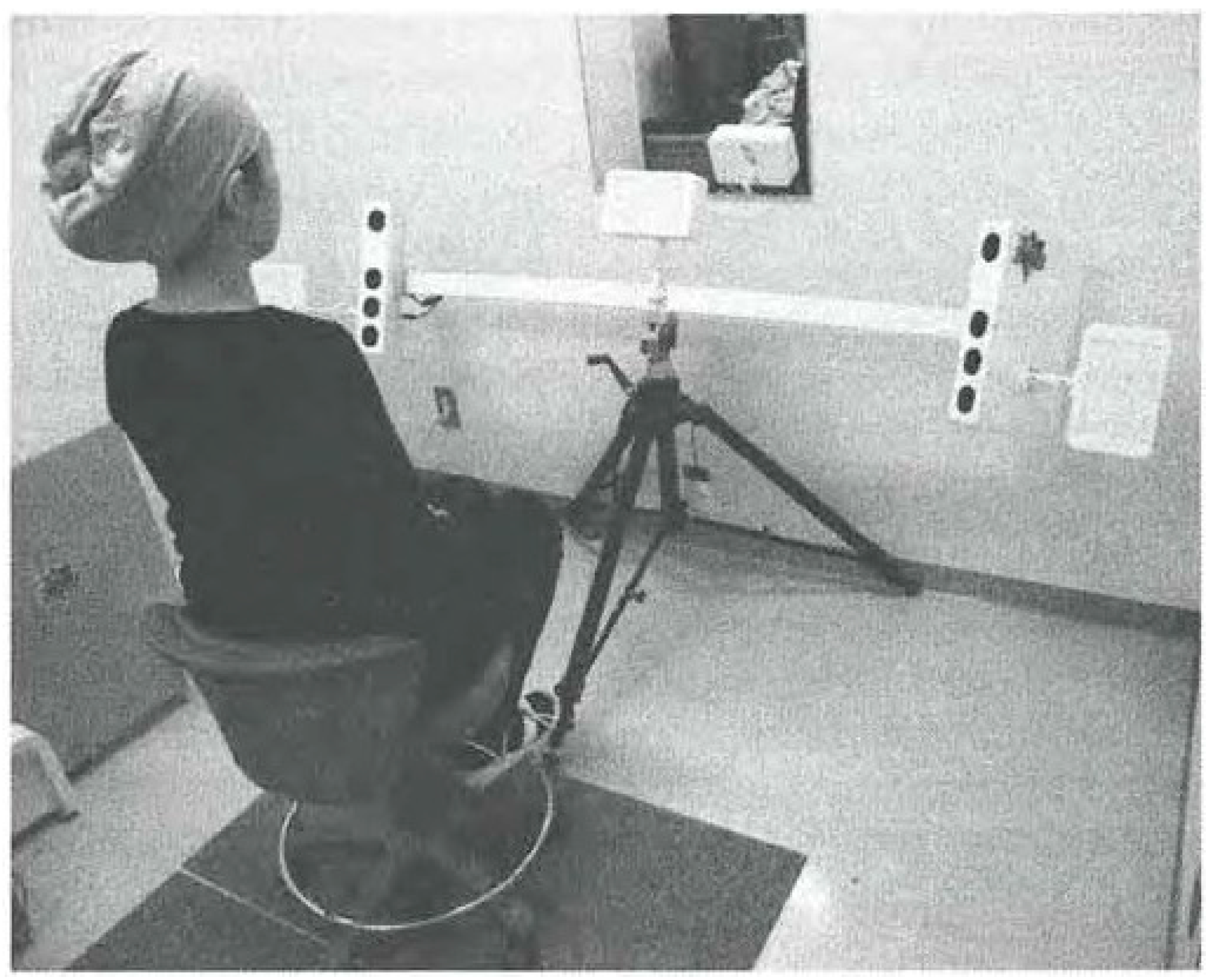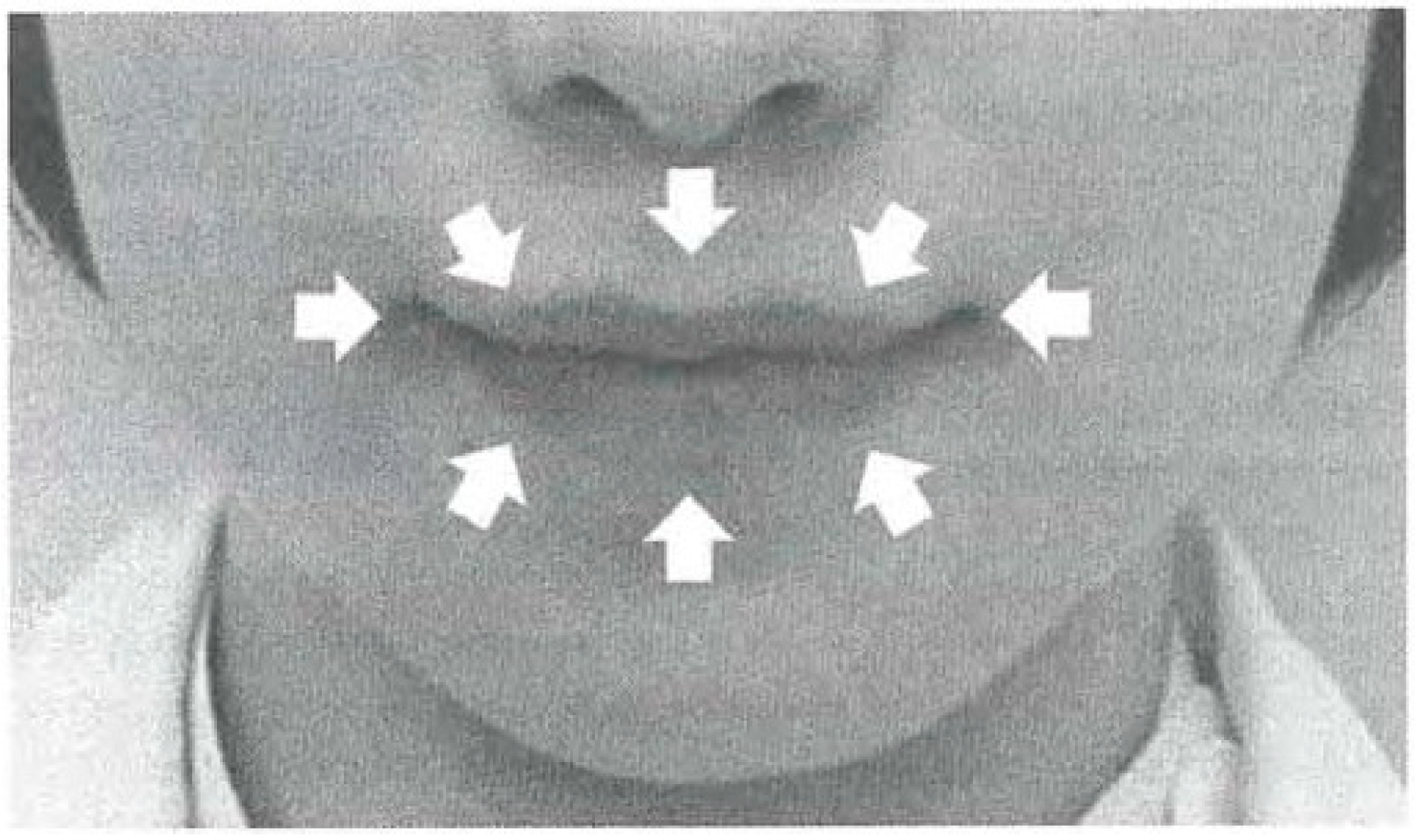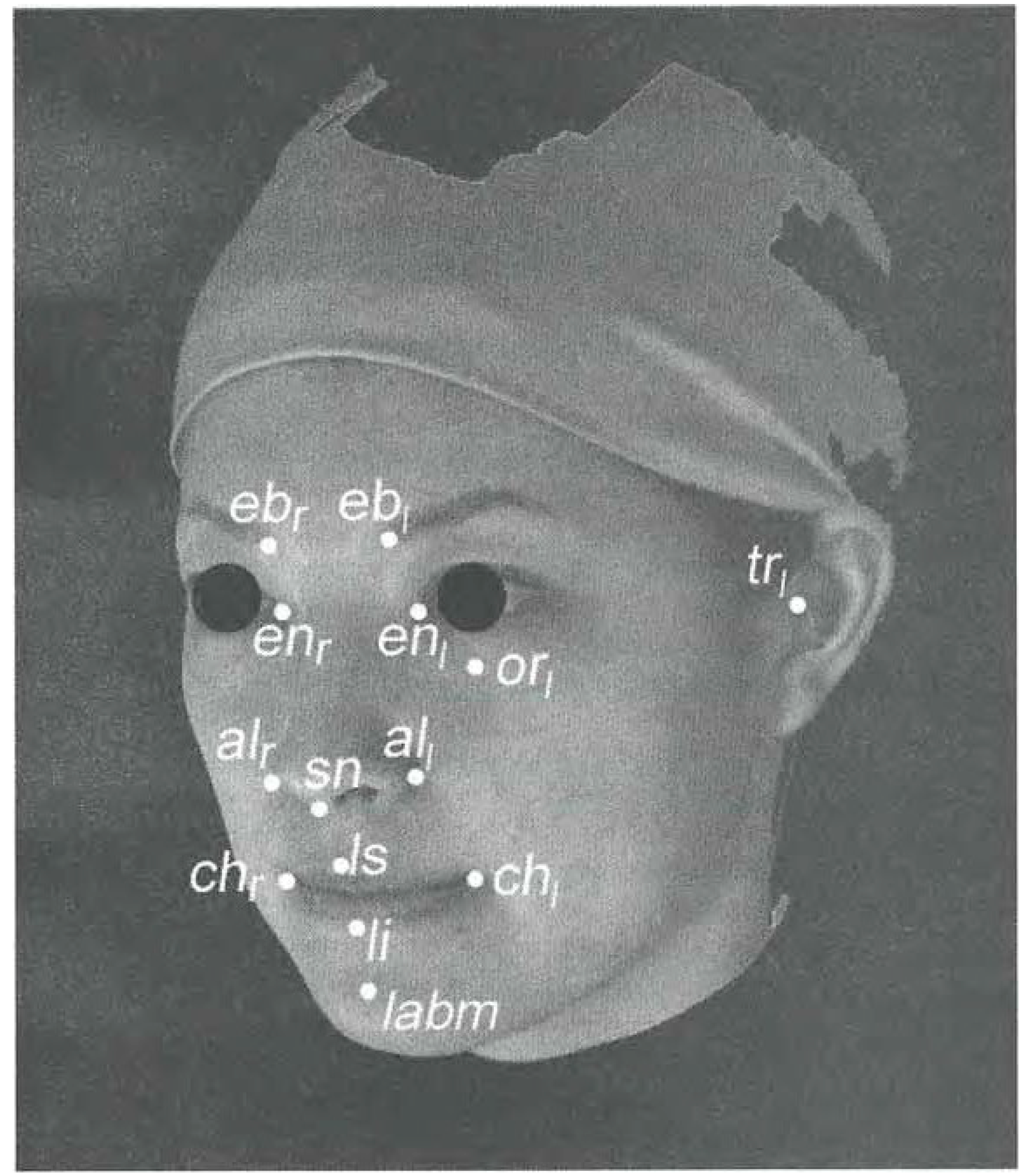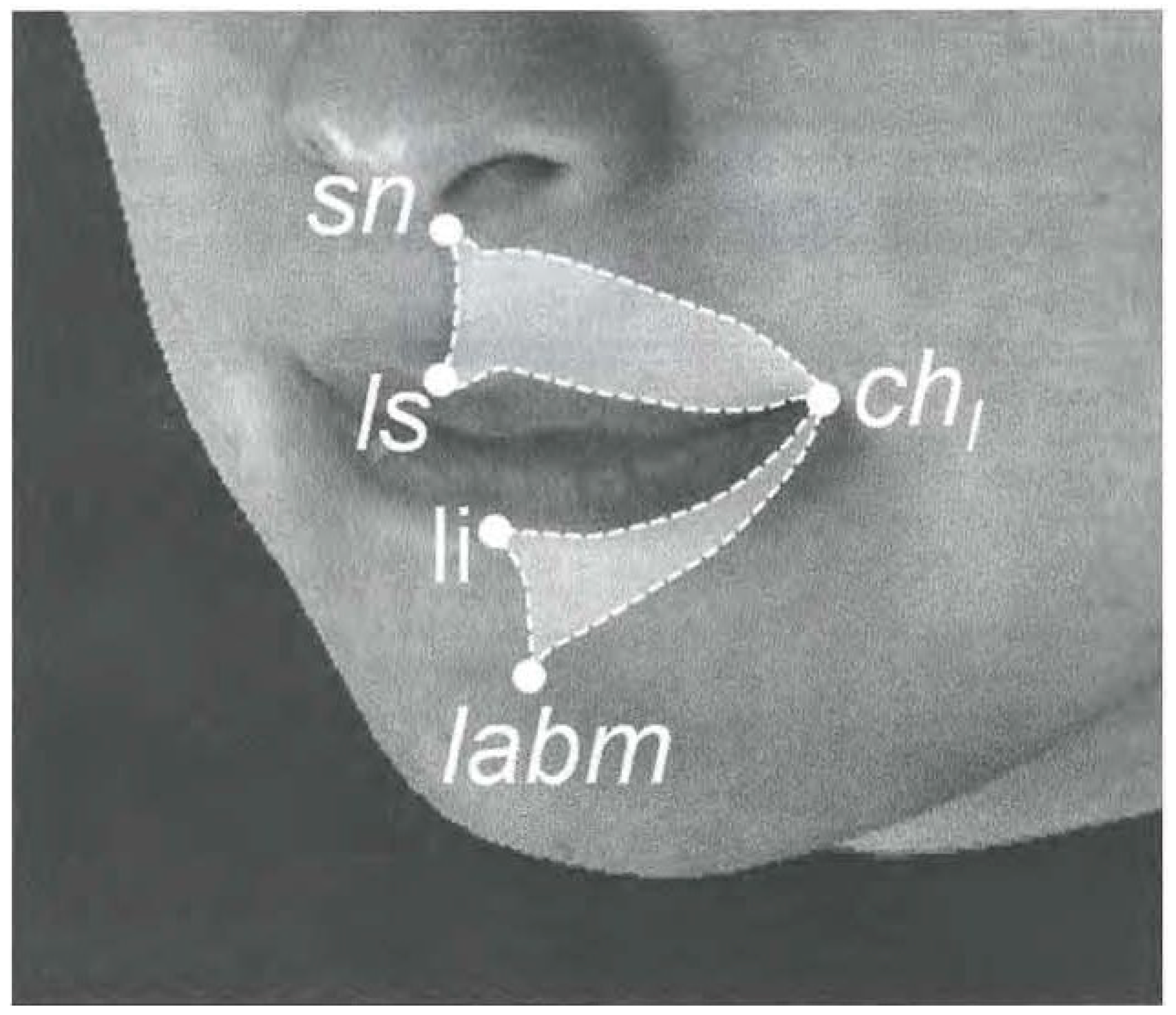Relationship Between Lip-Closing Force and Three-Dimensional Lip Morphology in Adults with Straight Facial Profile
Abstract
INTRODUCTION
MATERIALS AND METHODS
- Subjects
- Recording method
- Data analysesLip-closing force
- Three-dimensional image of the soft tissue around the lip
- Statistical analysis
RESULTS
DISCUSSION
CONCLUSIONS
- (1)
- Significant correlations were found between upper lip-closing force and upper lip morphology.
- (2)
- No correlation between tower lip-closing force and lower lip morphology was found.
Acknowledgments
References
- Artun, J., O. Krogstad, and R. M. Little. 1990. Stability of mandibular incisors following excessive proclination: A study in adults with surgically treated mandibular prognathism. Angle Orthodontist 60: 99–106. [Google Scholar]
- Brodie, A. 1953. Muscular factors in the diagnosis and treatment of malocclusions. Angle Orthodontist 23: 71–77. [Google Scholar]
- Davidovitch, M., D. Mcinnis, and S. J. Lindauer. 1997. The effects of lip bumper therapy in the mixed dentition. American Journal of Orthodontics and Dentofacial Orthopedics 111: 52–58. [Google Scholar] [CrossRef] [PubMed]
- Jung, M. H., W. S. Yang, and D. S. Nahm. 2003. Effects of upper lip closing force on craniofacial structures. American Journal of Orthodontics and Dentofacial Orthopedics 123: 58–63. [Google Scholar] [CrossRef] [PubMed]
- Jung, M. H., W. S. Yang, and D. S. Nahm. 2010. Maximum closing force of mentolabial muscles and type of malocclusion. Angle Orthodontist 80: 72–79. [Google Scholar] [PubMed]
- Kawabata, A., T. Kobayashi, A. Takagi, F. Kuroyanagi, K. Washino, K. Sabashi, and N. Kitai. 2013. Multidirectional lip-closing force in adults with mandibular deviation. Journal of Oral Rehabilitation 40: 664–669. [Google Scholar] [PubMed]
- Maeda, J., C. Ooshima, K. Saitoh, R. Kawashima, R. Hayashi, Y. Aoki, M. Yamaguchi, and K. Kasai. 2009. The correlation between the force of lip closure, the lip forms, and the upper and tower anterior teeth. Nihon University Journal of Oral Science 35: 33–40. [Google Scholar]
- Mills, J. R. 1966. The long-term results of the proclination of lower incisors. British Dental Journal 120: 355–363. [Google Scholar] [PubMed]
- Murakami, M., T. Adachi, K. Nakatsuka, T. Kato, M. Oishi, and Y. Masuda. 2012. Gender differences in maximum voluntary lip-closing force during lip pursing in healthy young adults. Journal of Oral Rehabilitation 39: 399–404. [Google Scholar] [PubMed]
- Nakatsuka, K., T. Adachi, T. Kato, M. Oishi, M. Murakami, Y. Okada, and Y. Masuda. 2011. Reliability of novel multidirectional lip-closing force measurement system. Journal of Oral Rehabilitation 38: 18–26. [Google Scholar] [PubMed]
- Ooishi, M., T. Adachi, K. Yasutomi, K. Nakatsuka, K. Yamada, and Y. Masuda. 2011. Multidirectional lip-closing force in the early stage of permanent anterior teeth occlusion (II)—Relationship between lip-closing force and lip morphology or anterior teeth occlusion. The Journal of Japanese Society of Stomatognathic Function 17: 104–112. [Google Scholar] [CrossRef][Green Version]
- Posen, A. L. 1972. The influence of maximum perioral and tongue force on the incisor teeth. American Journal of Orthodontics 42: 285–309. [Google Scholar]
- Posen, A. L. 1976. The application of quantitative perioral assessment to orthodontic case analysis and treatment planning. Angle Orthodontist 46: 118–143. [Google Scholar] [PubMed]
- Proffit, W. R. 1975. Muscle pressures and tooth position: North American whites and Australian aborigines. Angle Orthodontist 45: 1–11. [Google Scholar] [PubMed]
- Proffit, W. R., H. W. Fields, and O. M. Sarver. 2007. Contemporary orthodontics, 4th ed. St. Louis: Mosby Year Book Inc.: vol. p. 182. [Google Scholar]
- Rogers, C. R., M. P. Mooney, T. O. Smith, S. M. Weinberg, B. M. Waller, L. A. Parr, B. A. Docherty, C. J. Bonar, L. E. Reinholt, F. W. Deleyiannis, M. I. Siegel, M. L. Marazita, and A. M. Burrows. 2009. Comparative microanatomy of the orbicularis oris muscle between chimpanzees and humans: Evolutionary divergence of lip function. Journal of Anatomy 214: 36–44. [Google Scholar] [CrossRef] [PubMed]
- Rubens, B. C., and R. A. West. 1989. Ptosis of the chin and lip incompetence: consequences of lost mentalis muscle support. Journal of Oral and Maxillofacial Surgery 47: 359–366. [Google Scholar] [PubMed]
- Safeena, S., M. Najmuddin, and K. Reddy. 2012. Presurgical management of a child With missing lower lip using a new design of fixed lower tongue crib. Journal of the Indian Society of Pedodontics and Preventive Dentistry 30: 183–185. [Google Scholar] [CrossRef] [PubMed]
- Standring, S. 2008. Gray’s anatomy: The anatomical basis of clinical practice, 4th ed. London: Churchill Livingstone. [Google Scholar]
- Thuer, U., and B. Ingervall. 1986. Pressure from the lips on the teeth and malocclusion. American Journal of Orthodontics and Dentofacial Orthopedics 90: 234–242. [Google Scholar] [CrossRef] [PubMed]
- Wakabayashi, K. 2002. Relationship between maxillofacial morphology and perioral muscle function. Orthodontic Waves 61: 454–465. [Google Scholar]
- Yamaguchi, K., Y. Morimoto, R. S. Nanda, J. Ghosh, and K. Tanne. 2000. Morphological differences in individuals with lip competence and incompetence based on electromyographic diagnosis. Journal of Oral Rehabilitation 27: 893–901. [Google Scholar] [PubMed]






| Landmark | Definition |
|---|---|
| ebr | Eyebrow right. Inner end of the right eyebrow |
| ebI | Eyebrow left. Inner end of the left eyebrow |
| ebm | Eyebrow mid. Midpoint between ebr and ebI |
| enr | Entocanthion right. Inner commissure of the right eye fissure |
| enI | Entocanthion left. Inner commissure of the left eye fissure |
| enm | Entocanthion mid. Midpoint between enr and enI |
| alr | Alare right. Most prominent point of the right nasal alar contour |
| alI | Alare left. Most prominent point of the left nasal alar contour |
| aim | Alare mid. Midpoint between alr and alI |
| orI | Orbitale left. Most inferior point of the orbit |
| trI | Tragion left. Most inferior point of the anterior part of the left tragus |
| sn | Subnasale. Deepest point of the lower part of the nose |
| chr | Cheilion right. Angle of mouth on the right side |
| chI | Cheilion left. Angle of mouth on the left side |
| chm | Cheilion mid. Midpoint between chr and chI |
| ls | Labral superiors. Intersection between upper vermilion border and MSP |
| li | Labral inferiors. Intersection between lower vermilion border and MSP |
| lamb | Labiodental. Intersection between mentolabial sulcus and MSP |
| Variables | Definition |
|---|---|
| Lip width | Horizontal distance between chr and chI |
| Upper lip height | Vertical distance between sn and ls |
| Lower lip height | Vertical distance between li and lamb |
| Upper lip depth | Anteroposterior distance between chm and ls |
| Lower lip depth | Anteroposterior distance between chm and li |
| Upper right lip base length | Linear distance between sn and chr |
| Upper left lip base length | Linear distance between sn and chI |
| Lower right lip base length | Linear distance between lamb and chr |
| Lower left lip base length | Linear distance between lamb and chI |
| Upper right lip surface length | Surface contour between sn and chr |
| Upper left lip surface length | Surface contour between sn and chI |
| Lower right lip surface length | Surface contour between lamb and chr |
| Lower left lip surface length | Surface contour between lamb and chI |
| Upper right lip surface area | Surface area enclosed by sn-chr, sn-ls, and upper vermilion border |
| Upper left lip surface area | Surface area enclosed by sn-chI, sn-ls, and upper vermilion border |
| Lower right lip surface area | Surface area enclosed by lamb-chr, lamb-li, and lower vermilion border |
| Lower left lip surface area | Surface area enclosed by lamb-chI, lamb-li, and lower vermilion border |
| DLCF (N·s) | Median | Minimum | Maximum |
|---|---|---|---|
| Upper | 3.16 | 0.81 | 5.65 |
| Upper right | 1.60 | 0.06 | 4.37 |
| Upper left | 1.62 | 0.15 | 3.79 |
| Lower | 3.33 | 0.94 | 7.24 |
| Lower right | 1.84 | 0.34 | 4.68 |
| Lower left | 1.72 | 0.18 | 4.15 |
| Right | 0.51 | 0.00 | 2.32 |
| Left | 0.49 | 0.00 | 2.36 |
| Measurement Variable | Median | Minimum | Maximum |
|---|---|---|---|
| (mm) | |||
| Lip width | 51.5 | 46.5 | 61.0 |
| Upper lip height | 23.5 | 16.0 | 31.5 |
| Lower lip height | 19.5 | 11.5 | 25.5 |
| Upper lip depth | 16.1 | 12.9 | 22.1 |
| Lower lip depth | 11.0 | 5.2 | 16.9 |
| Upper right lip base length | 38.0 | 33.5 | 45.8 |
| Upper left lip base length | 38.0 | 33.0 | 47.4 |
| Lower right lip base length | 32.1 | 28.5 | 36.5 |
| Lower left lip base length | 33.5 | 26.5 | 37.6 |
| Upper right lip surface length | 39.9 | 35.2 | 49.7 |
| Upper left lip surface length | 39.1 | 34.5 | 51.0 |
| Lower right lip surface length | 35.7 | 31.8 | 41.4 |
| Lower left lip surface length | 36.6 | 30.0 | 40.9 |
| (mm2) | |||
| Upper right lip surface area | 228.9 | 107.7 | 347.8 |
| Upper left lip surface area | 234.7 | 104.8 | 338.0 |
| Lower right lip surface area | 135.3 | 61.1 | 246.2 |
| Lower left lip surface area | 149.8 | 46.9 | 298.2 |
| Lip-Closing Force/Measurement Variable | Correlation Coefficient | p-Value |
|---|---|---|
| Total upper/Lip width | 0.543 | 0.007 * |
| Total upper/Upper lip height | 0.542 | 0.008 * |
| Total upper/Upper lip depth | 0.482 | 0.020 * |
| Total lower/Lip width | 0.328 | 0.126 |
| Total lower/Lower lip height | −0.007 | 0.976 |
| Total lower/Lower lip depth | 0.017 | 0.938 |
| Upper right/Upper right lip base length | 0.574 | 0.004 * |
| Upper left/Upper left lip base length | 0.595 | 0.003 * |
| Upper right/Upper right lip surface length | 0.613 | 0.002 * |
| Upper left/Upper left lip surface length | 0.725 | 0.000 * |
| Upper right/Upper right lip surface area | 0.619 | 0.002 * |
| Upper left/Upper left lip surface area | 0.694 | 0.000 * |
| Lower right/Lower right lip base length | 0.203 | 0.354 |
| Lower left/Lower left lip base length | 0.262 | 0.227 |
| Lower right/Lower right lip surface length | 0.279 | 0.198 |
| Lower left/Lower left lip surface length | 0.271 | 0.211 |
| Lower right/Lower right lip surface area | 0.208 | 0.342 |
| Lower left/Lower left lip surface area | 0.353 | 0.098 |
© 2015 by the author. 2015 Asuka Fujiwara, Fumi Kuroyanagi, Atsushi Kawabata, Atsushi Fujiwara, Wakako Tome and Noriyuki Kital
Share and Cite
Fujiwara, A.; Kuroyanagi, F.; Kawabata, A.; Fujiwara, A.; Tome, W.; Kitai, N. Relationship Between Lip-Closing Force and Three-Dimensional Lip Morphology in Adults with Straight Facial Profile. Int. J. Orofac. Myol. Myofunct. Ther. 2015, 41, 24-36. https://doi.org/10.52010/ijom.2015.41.1.3
Fujiwara A, Kuroyanagi F, Kawabata A, Fujiwara A, Tome W, Kitai N. Relationship Between Lip-Closing Force and Three-Dimensional Lip Morphology in Adults with Straight Facial Profile. International Journal of Orofacial Myology and Myofunctional Therapy. 2015; 41(1):24-36. https://doi.org/10.52010/ijom.2015.41.1.3
Chicago/Turabian StyleFujiwara, Asuka, Fumiyo Kuroyanagi, Atsushi Kawabata, Atsushi Fujiwara, Wakato Tome, and Noriyuki Kitai. 2015. "Relationship Between Lip-Closing Force and Three-Dimensional Lip Morphology in Adults with Straight Facial Profile" International Journal of Orofacial Myology and Myofunctional Therapy 41, no. 1: 24-36. https://doi.org/10.52010/ijom.2015.41.1.3
APA StyleFujiwara, A., Kuroyanagi, F., Kawabata, A., Fujiwara, A., Tome, W., & Kitai, N. (2015). Relationship Between Lip-Closing Force and Three-Dimensional Lip Morphology in Adults with Straight Facial Profile. International Journal of Orofacial Myology and Myofunctional Therapy, 41(1), 24-36. https://doi.org/10.52010/ijom.2015.41.1.3




